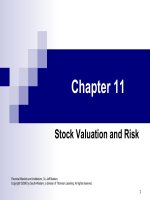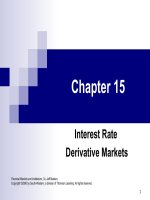Thị trường tài chính và các định chế tài chính_ Chapter 08
Bạn đang xem bản rút gọn của tài liệu. Xem và tải ngay bản đầy đủ của tài liệu tại đây (332.08 KB, 38 trang )
1
Chapter 8
Bond Valuation and Risk
Financial Markets and Institutions, 7e, Jeff Madura
Copyright ©2006 by South-Western, a division of Thomson Learning. All rights reserved.
2
Chapter Outline
Bond valuation process
Relationships between coupon rate, required
return, and bond price
Explaining bond price movements
Sensitivity of bond prices to interest rate
movements
Bond investment strategies used by investors
Return and risk of international bonds
3
Bond Valuation Process
Bonds:
Are debt obligations with long-term maturities issued by
government or corporations to obtain long-term funds
Are commonly purchased by financial institutions that wish to
invest for long-term periods
The appropriate bond price reflects the present value of
the cash flows generated by the bond (i.e., interest
payments and repayment of principal):
n
k
C
k
C
k
C
PV
)1(
Par
....
)1()1(
bond of
21
+
+
+
+
+
+
=
4
Computing the Current Price of
A Bond
A 2-year bond has a par value of $1,000 and a
coupon rate of 5 percent. The prevailing
annualized yield on other bonds with similar
characteristics is 7 percent. What is the
appropriate market price of the bond?
84.963
07.1
050,1
07.1
50
)1(
Par
....
)1()1(
bond of
2
21
=
+=
+
+
+
+
+
+
=
n
k
C
k
C
k
C
PV
5
Bond Valuation Process (cont’d)
Bond valuation with a present value table
Present value interest factors in Exhibit 8A.3 can be
multiplied by coupon payments and the par value to determine
the present value of the bond
Impact of the discount rate on bond valuation
The appropriate discount rate for valuing any asset is the yield
that could be earned on alternative investments with similar
risk and maturity
Investors use higher discount rates to discount the future cash
flows of riskier securities
The value of a high-risk security will be lower than the value of
a low-risk security
6
Computing the Current Price of
A Bond Using PVIFs
A 2-year bond has a par value of $1,000 and a
coupon rate of 5 percent. The prevailing
annualized yield on other bonds is 7 percent.
What is the appropriate market price of the
bond using PVIFs?
80.963$
07.917$73.46$
)8734(.050,1$)9346(.50$
)(050,1$)(50$bond of
2%,71%,7
=
+=
+=
+=
==== nknk
PVIFPVIFPV
7
Bond Valuation Process (cont’d)
Impact of the timing of payments on bond valuation
Funds received sooner can be reinvested to earn additional
returns
A dollar to be received soon has a higher present value than
one to be received later
Valuation of bonds with semiannual payments
First, divide the annual coupon by two
Second, divide the annual discount rate by two
Third, double the number of years
n
k
C
k
C
k
C
PV
221
)2/1(
Par2/
....
)2/1(
2/
)2/1(
2/
bond of
+
+
+
+
+
+
=
8
Computing the Current Price of
A Bond With Semiannual
Coupons
A 2-year bond has a par value of $1,000 and a
semiannual coupon rate of 5 percent. The
prevailing annualized yield on other bonds with
similar characteristics is 7 percent. What is the
appropriate market price of the bond?
27.963
035.1
025,1
035.1
25
035.1
25
035.1
25
)2/1(
Par2/
....
)2/1(
2/
)2/1(
2/
bond of
4321
221
=
+++=
+
+
+
+
+
+
=
n
k
C
k
C
k
C
PV
9
Bond Valuation Process (cont’d)
Use the annuity tables for valuation
A bond can be valued by separating its payments
into two components:
PV of bond = PV of coupon payments + PV of principal
The bond’s coupon payments represent an annuity
(an even stream of payments over a given period of
time)
The present value can be computed using PVIFAs
10
Computing the Current Price of
A Bond Using PVIFs and PVIFAs
A 30-year bond has a par value of $1,000 and an annual
coupon rate of 10 percent. The prevailing annualized
yield on other bonds with similar characteristics is 9
percent. What is the appropriate market price of the
bond?
1,102.80$$75.40$1,027.40bond of
40.75$)0754(.000,1$
)(000,1$principal of
40.027,1$)274.10(100$
)(payments coupon of
30%,9
30%,9
=+=
==
=
==
=
==
==
PV
PVIFPV
PVIFACPV
nk
nk
11
Relationship between Coupon
Rate, Required Return, and Price
If the coupon rate of a bond is below the
investor’s required rate of return, the present
value of the bond should be below par value
(discount bond)
If the coupon rate equals the required rate of
return, the price of the bond should be equal to
par value
If the coupon rate of a bond is above the
required rate of return, the price of the bond
should be above par value
12
Relationship between Coupon
Rate, Required Return, and Price
13
Relationship between Coupon
Rate, Required Return, and Price
(cont’d)
Implications for financial institutions
The impact of interest rate movements depends on how the
institution’s asset and liability portfolios are structured
Institutions with interest rate-sensitive liabilities that invest heavily in
bonds are exposed to interest rate risk
Many institutions adjust the size of their bond portfolio according to
interest rate expectations
When rates are expected to rise, bonds can be sold and the
proceeds used to purchase short-term securities
When rates are expected to fall, the bond portfolio can be expanded
in order to capitalize on the expectations
14
Explaining Bond Price Movements
The price of a bond should reflect the present
value of future cash flows based on a
required rate of return:
An increase in either the risk-free rate or the
general level of the risk premium results in a
decrease in bond prices
- - -
),()( RPRfkfP
fb
∆∆=∆=∆
15
Explaining Bond Price Movements
(cont’d)
Factors that affect the risk-free rate
Inflationary expectations
Economic growth
Money supply
Budget deficit
+++
∆∆∆∆=∆
-
),,,( DEFMSECONINFfR
f









